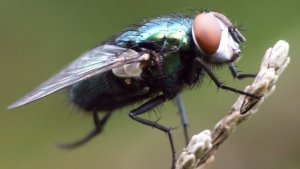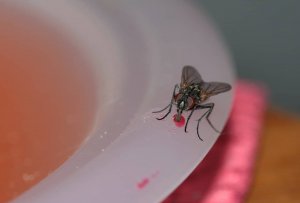Probably not the most appetizing thing to think about before or after consuming a meal, it is, however, an important question, especially if flies abound in your Pittsburgh home or office.
It is far from comforting to know that according to our pest-control and pest-management specialists at Pestco, most species hatch and reproduce very quickly.
They can be hazardous to human health and well-being in addition to a pain in places too impolite to mention.

What Are Flies And Why Are They Here?
Flies are insects of the order, Diptera, a name which derives from the Greek words di, meaning two, and pteron translating to wing.
In nature, there are more than 110,000 fly species, and each has its own habitat and characteristics.
Flies have two sets of fully developed wings; one on the thorax and another called halteres, which serves as an aid for balance. Their six legs have five segments, and they also connect to the thorax.
The housefly is known for its hard exoskeleton, which protects it from moisture loss.
Flies are known to swarm due to a complex communion of winter rainfall, availability of food sources and rising temperatures.

Despite their annoying presence and the fact that many species transmit diseases such as: dysentery, typhoid fever and cholera just to name a few, flies do have their place within Mother Nature’s order of things. They aid in the pollination of plants, the breaking down of organic material and serve as food for other bugs and animals.
According to Dr. Brian Lestard of the Australian National Insect Collection: “Recent research shows that the common blow fly can carry more pollen on its body than a honeybee.”
The Breeding Habits Of Various Flies
Flies lay their legs indoors and outdoors, depending on the species. More on the most commonly found species follows below.
The House Fly
The elongated pale eggs of the average house fly appear in clusters, and are often found in decaying organic material such as:trash; grass clippings; feces or on large numbers of dead insects.
One female can lay up to 500 eggs within three to four days.
She can repeat this cycle many times over the course of her lifetime, which is usually 15 to 25 days and can be up to two months under favorable conditions.
Keep in mind that flies feed on and lay eggs in anything that is rotting or putrefying.
The likely breeding sites for house fly larvae indoors include animal carcasses, large numbers of dead insects, rotting meat or produce.
A single female can lay about 500 eggs in her lifetime and the entire life cycle from egg to adult only takes only a week.
Fruit flies lay their eggs near the surface of fermenting foods or other moist, organic materials. When the tiny larvae emerge, they feed near the surface of the rotting material.
Our experts at Pestco know that while fruit flies can be a problem every season of the year, they are especially prevalent during late summer and early autumn because they are attracted to ripened or fermenting fruits and vegetables such as: bananas; onions; potatoes; melons; tomatoes; grapes; squash and other garden and grocery store perishables.
Drain Flies
Also known as: sink flies; filter flies; sewer flies; sewer gnats and moth flies, these insects thrive on moisture, and often lay their eggs in the slimy film that forms in drain pipes, sewers and garbage disposals.
Experts often warn that without regular cleaning in these areas, a drain fly infestation can occur in what might seem like just a few heartbeats.
Blow Flies
Blow fly eggs, which are also known as maggots, are laid on decaying meat and animal feces, where they are known to hatch within a few hours to several days, depending on species.
They measure from 3/8th to 7/8th of an inch in length and have hook-like mouthparts and spiracles for breathing. In appearance, eggs are soft and resemble grains of rice.
They undergo three separate stages of development after which they leave their source of food and pupate in soil before emerging as adults. As larvae, they create outer skins, which resemble rat droppings or cockroach egg cases.
Fungus gnats resemble mosquitoes, but they do not bite. They are often found resting on plants, soil, windows or walls.
Females lay their eggs in moist organic matter and often gain ingress to Pittsburgh homes via infested houseplants.
They feed on the fungi in the soil and damaged or decaying plant roots. Left to reproduce, pest-control specialists warn that they can be quite annoying and pose danger to young house plants with more delicate root systems.
Where Do Flies Lay Their Eggs Outdoors?
Stable and cluster flies lay they eggs outside homes, and their feeding habits can be quite problematic.
During the summer months, both are very active outdoors. Cluster flies as larvae are parasitic and females lay their eggs near the openings of earthworm burrows, which are their food source.
After the eggs hatch, the larvae invade the burrow and penetrate the bodies of the earthworms. Stable flies lay their eggs in animal waste, rotting vegetation and other decaying matter.
They are known to bite both humans and horses, as they require a blood meal in order to develop their eggs.
Tips To Prevent Flies From Laying Eggs In Homes
We recommend the following measures to prevent flies from laying eggs in your home.
1. Remove Potential Breeding Sources
Since they feed and reproduce in filth very rapidly, it is important to remove that which attracts them. This include: decaying meat, fruit, waste matter, vegetables and trash.
2. Keep Kitchens Clean
Sweep floors frequently and make sure to remove crumbs that can easily accumulate behind toasters, coffee machines and other small appliances as they can easily be overlooked.
3. Close Doors And Windows
Flies love sunlight and warmth, which is why they are so often found buzzing against windows.
Always make sure when you keep a window open that is fitted with a tight-fitting screen that has no cracks or damage of any kind. Avoid leaving doors without screens open for long periods of time.
Automatic door closing devices and air curtains that blow air away from doorways can be installed to supplement an integrated fly management program.
4. Seal Trash Carefully
Pittsburgh homeowners should use sealed containers (in trash bags and/or cans with tight-fitting lids).
Garbage cans should be sealed whenever they are not in use. Keep dumpsters as clean and as far away from the home as possible and empty them regularly.
Remove manure, decaying plant and animal materials and areas with excessive moisture.
5. Inspection Is The Key To Sanitation
This will require the help of professional technicians, as locating the source of an infestation is not always easy and it is vital to eliminating the problem.
One must know what to look for and where it is most likely to be found. A first step is the identification of the flies involved, knowing what attracts that species and then eliminating that material.
In conclusion
If you see many flies inside or outside your home, contact our teams today before the infestation gets worse. We’re always here to help!
Photo Credits: Pixabay
 Over 300 Reviews
Over 300 Reviews 